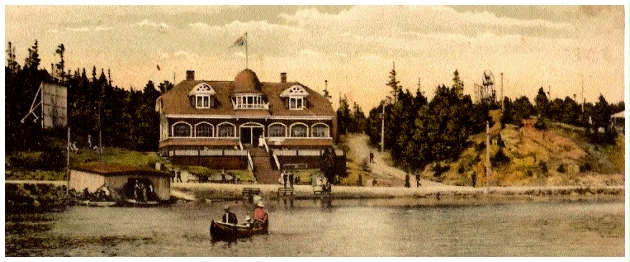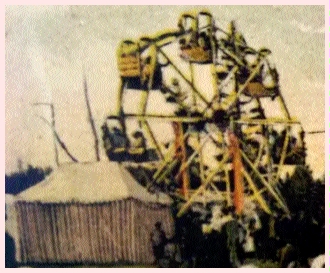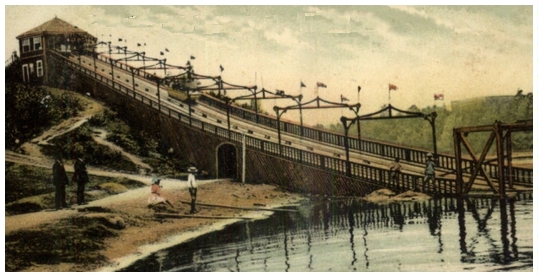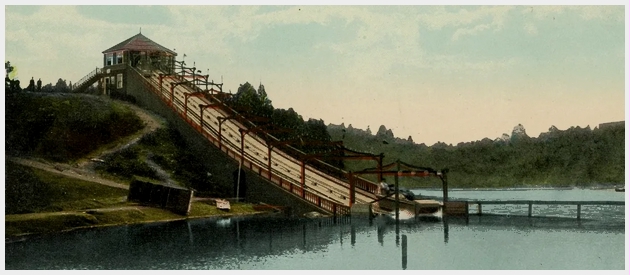
NEW BRUNSWICK

Saint John
NO PART OF THE FOLLOWING
ARTICLE AND PHOTOGRAPHS
MAY BE REPRODUCED WITHOUT
PERMISSION FROM THE AUTHOR ©
The name is pronounced by locals as
"ROOK-wood", with a short, double `oo' sound.
Starting in the 1890s as a nature park built up around Lilly Lake by the local horticultural association, it came to have beautiful gardens and a zoo by 1895. However over the first decade or so, incidents regarding animal attacks and visitors throwing things at them were reported. In addition, too much money had been spent, and to compensate, the park was leased to Frank White, a local business person. He had electrical service brought in to power lighting in the area at night; some structures were built, and rides were added.
In 1907, July 1, a soft opening of the revamped park occurred, which by then had a dance Pavilion, a bandstand, a restaurant which served alcohol as well as food, and swan and row boats on the lake. On Saturday July 6th, the formal grand opening occurred with Saint John's mayor officiating over an estimated crowd of 12,000. Fireworks capped off the celebrations.
Photo research shows that the Pavilion area changed over time. Before the building was constructed, a small beach existed on the opposite shore from which one could see an empty area where the Pavilion would eventually be built. Once it came to be, the beach still existed, but there was little along the lakeshore on the Pavilion side, other than some park-style benches. Boats were being rented from a small building nearby, however.
As time progressed, the Pavilion would have much built up around it. An entryway arch was placed at the bottom of the main stairway that led to the building's two decks. On either side of he stairs at the bottom was constructed a small building; these appear to be for concessions, but may have been for boat rentals, if the nearby building ceased to be used for that purpose. The lakeshore in front came to have a fence along the pathway, and many more benches were installed. Below the path, rock in-fill was placed to improve the look of the area, and likely to stem erosion. Also added was another electrical pole that perhaps held a light used to illuminate the pathway.
|
Rockwood Pavilion 1910s 
|
|
The magnificent Pavilion with its
two decks provides an excellent
view of the lake from their heights
above everything below. Notice the "Rock Wood" archway at the foot of the wide, central staircase. The two buildings in front seem to be concessions, or possibly boat rentals. Just barely seen at Lower Left is part of a small pier. |
|
The Pavilion Late 19-0s 
|
|
This earlier view shows a few benches,
but no railing or rock wall along the
shore, and no stairway entry arch or
its adjacent buildings. The low building
on the left was for boat rentals. At Far Center Right is a tent that housed the carousel. On top of the hill appears to be the ferris wheel. Note the electrical poles spaced along the hill and down to the road, then to the water. The purpose of the screen-like structure at Upper Left is unknown. |
|
Lake Bridge Late 19-0s 
|
| An even earlier view shows no electrical pole at the shore, and even fewer benches. |
|
The Lake 1890s ? 
|
| A photo from before the build-up shows the lake with a rocky beach. Across from this is where the future Pavilion will be built to the left of the dirt road and mound. This mound would not be developed, and so is seen in the previous two images from later times. |
Rides included a tent-covered carousel, and a (reportedly) 7.5-metre ferris wheel with six tubs, each holding four persons. The wheel shown seems to be much smaller, and the seats might hold four persons -- if two were children.
|
Carousel 19-0s 
|
Notice the electrical wires crossing horizontally above the tent top. The other lines are supporting the main tent pole. |
| A fuzzy postcard image shows the small size of the wheel. Already by the mid 19-0s, park-model ferris wheels were twice this size. |
Ferris Wheel 19-0s 
|
Later that month a "Shoot-the-Chutes" opened. (Shown on some postcards as "Shoot-the-Shutes".) This was a great attraction in many Canadian parks of the era. It consisted of a long ramp upon which flat-bottomed boats traveled down at high speed within a wooden trough where upon they would exit and skim across a pond of water. Riders got off, while an attendant would remain aboard to guide the empty boats to a lift mechanism which brought them to the top once more where waiting people queued.
|
Shoot the Chutes 19-0s 
|
|
This postcard view gives an idea
of the size of this ride, and also
detail of the structure itself. Note the two workers at the bottom of the `Up' ramp. They are likely there to assist guiding the empty boats on to the lift mechanism. |
| Below is a later view. Lights have been added to each overhead arch. To the left is what appears to be a watercraft with multiple bench seats. It is lying on the shore on its side. There is also a structure to the right that may have been a walkway for ride attendants to go quickly from the ride to the far shore where boats would end up. |

|
For the ride's opening, a daredevil stunt was performed by a park vendor, Crowell Fish (or Charles from another source), which saw him ride a bicycle down the "Chutes" ramp. When he hit the water the bike slowed quickly, tossing him over the handlebars into the water ahead. This was unplanned, but the crowd gave its approval thinking it was part of the stunt. Fish was unhurt, and he went on to take the same ride into the water throughout that summer.
During the off season, the park itself remained accessible. People could hike the trails or have early/late picnics. In winter, skating parties were held on the frozen lake.
Frank White's lease was contracted to run until 2016, but the Great War, which started in August of 1914, took away the desire of such amusements for many, as well as took away young men to the battle fields of Europe. No details have been yet found, but it is assumed that Frank did not renew his lease.
One source says the amusements began to lose their appeal in 2012 as that is given as one of the possible years that the Pavilion was destroyed by fire. However, another source says the fire occurred in 1914, which is also cited as the year the park declined. It is unknown what happened to the rides and other attractions, but the park itself lived on.
In the 1920s, speed-skating championship competitions were held, and the park has remained a popular nature park right to the present era. A pavilion was built in the 1950s but it too burned. A modern one was erected in the 1970s which stands today. It houses a restaurant.
The area currently advertises walking and bike trails, swimming, boating, golfing, camping, and food concessions, plus a small convention centre or rental space for gatherings, weddings, and meetings.
|
Thanks to Jim Abbate of Chicago for suggesting this park and providing
details.
|
Return to the
Closed Canadian Parks Index
